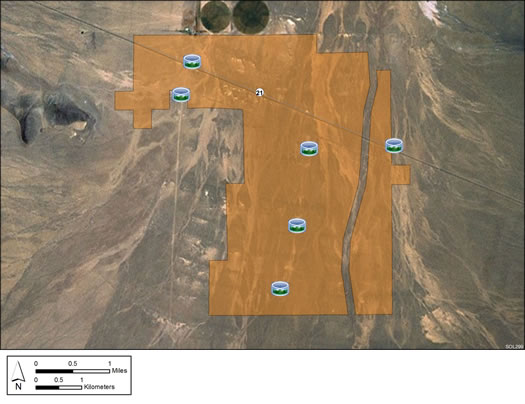The Approved Record of Decision for Resource Management Plan Amendments for Utility-Scale Solar Energy Development was issued on December 20th, 2024 — details are available on the BLM's Utility-Scale Solar Energy Development PEIS/RMPA webpage. Relevant information on the 2024 Western Solar Plan and the BLM's Renewable Energy Rule issued in July 2024, is in the process of being updated on this website.
| Utah Variance Areas | Wah Wah Valley SEZ |
 |
 |
The Wah Wah Valley Solar Energy Zone (SEZ) is a designated leasing area (DLA) located in Utah northwest of the Escalante Desert. The SEZ is located on BLM-administered land within the Cedar City Field Office.
The Wah Wah Valley SEZ has a total area of 6,097 acres (25 km2). In the 2011 Supplement to the Draft Solar PEIS, 224 acres (0.91 km2) of the Wah Wah Wash were identified as non-development areas, leaving the SEZ with a potential developable area of 5,873 acres (23.8 km2). No additional changes to the SEZ developable area were made in the 2012 Final Solar PEIS.
The Wah Wah Valley SEZ is located in Beaver County. The SEZ lies in Wah Wah Valley, a narrow valley northwest of the Escalante Desert across the Shauntie Hills, and between Wah Wah Mountains to the west and southwest, Shauntie Hills to the south and southeast, and San Francisco Mountains to the east. In 2008, the county population was 7,265, while adjacent Iron County to the south had a population of 45,833. The largest nearby town is Cedar City about 50 mi (80 km) southeast.

Land within the SEZ is rural, undeveloped scrubland characteristic of a high-elevation, semiarid basin. Vegetation consists primarily of low shrubs with broad expanses of gravel and sand flats.
State Route 21 passes through the northern portion of the SEZ. A ranch with some land under irrigation is located at the northern boundary of the SEZ. An historic power line, unpaved roads and wire fences cross the SEZ. Part of the SEZ is authorized by the BLM for grazing. The SEZ may be used by local residents for general outdoor recreation, including backcountry driving and off-highway vehicle use, recreational shooting, and small and big game hunting.
Mountains surround this remote location, and there are few people living nearby.

There is good access to the SEZ from State Route 21, which runs from west to east through the northern half of the SEZ. Transmission access to the Wah Wah Valley SEZ does not exist. The availability of existing transmission near the SEZ is under investigation, but there is a designated transmission corridor running east-west through the SEZ along State Route 21.
In the 2012 Solar PEIS, the BLM committed to establishing a monitoring and adaptive management strategy for each solar energy zone (SEZ). Through these strategies, the BLM will take an active role in the collection of baseline data for the SEZs.
The BLM has not yet begun the monitoring and adaptive management strategy for the Wah Wah Valley SEZ. However, the BLM has conducted a pilot monitoring and adaptive management strategy for the Riverside East SEZ. In May 2016, the BLM released the Riverside East Solar Energy Zone Long Term Monitoring Strategy Final Report. The monitoring strategy document (PDF, 16.6 MB) is now available.
In the 2012 Solar PEIS, the BLM committed to preparing solar regional mitigation strategies (SRMSs) for the solar energy zones (SEZs). These regional mitigation strategies were intended to simplify and improve the mitigation process for future solar projects in SEZs.
In 2016, the BLM began development of a solar regional mitigation strategy (SRMS) for three Utah SEZs: the Escalante Valley, Milford Flats South, and Wah Wah Valley SEZs. Information on the draft Utah Solar Regional Mitigation Strategy is available on the project website, linked below.
With IM-2019-018, the BLM established policy that compensatory mitigation could not be required as a condition for project approvals. However, with the issuance of IM 2021-038 on July 14, 2021, the BLM rescinded the previous IM-2019-018. The BLM expects to establish policies which are aligned with EO 13990, SO 3398, and the priorities of the Department. During this interim period offices should consider and implement compensatory mitigation on a case-by-case basis, in consultation with state office and national office program specialists and the Office of the Solicitor as needed.
Interested parties can learn more by visiting the Utah SRMS project website at:
https://blmsolar.anl.gov/solar-peis/sez/ut/regional-mitigation/